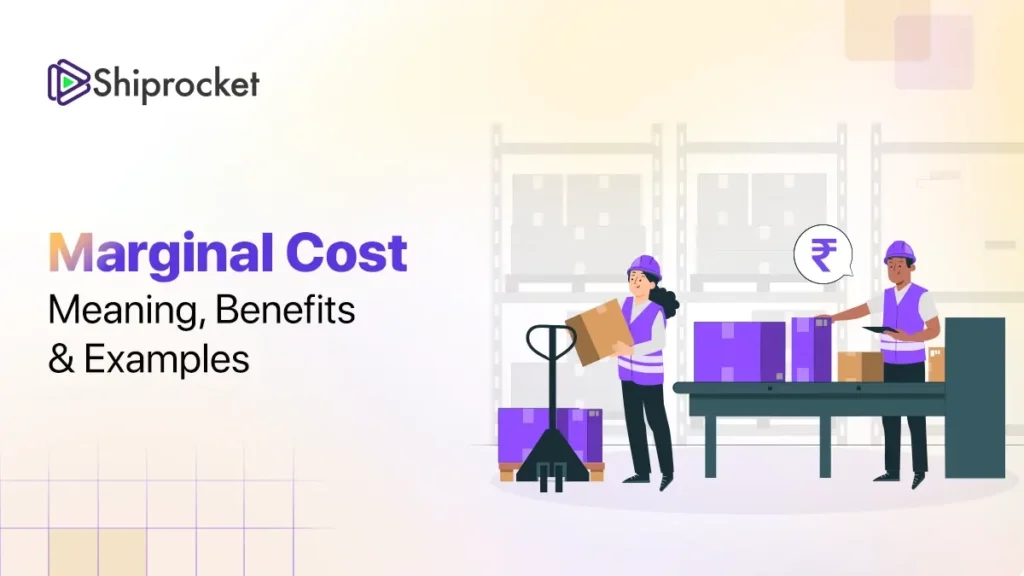- The Basics of Marginal Cost
- Insights from Marginal Cost Analysis
- Calculating Marginal Cost
- What is the Marginal Cost Calculator?
- Example of Marginal Cost Formula
- Advantages of Using Marginal Cost in Business
- Practical Applications of Marginal Cost
- The Importance of Marginal Cost
- Comparing Marginal Cost vs. Average Cost
- Interpreting the Marginal Cost Curve
- Relationship Between Marginal Cost and Marginal Revenue
- Role of Marginal Cost in Business Efficiency
- Fields That Utilise the Marginal Cost Formula
- Understanding Marginal Cost in Relation to Economies of Scale
- Conclusion
Marginal Cost or incremental cost is a microeconomic concept that refers to the change in total production cost based on the manufacturing of additional units. Many businesses use this concept to determine cost-effective production in the short run.
Marginal cost helps gauge the contribution margin and assists in making decisions related to pricing, production, and profitability.
This blog will discuss the role of marginal cost in business and its various other aspects. So, let’s dive in!

The Basics of Marginal Cost
The extra expense incurred by a business when production quantity is increased is the marginal cost. The additional expense “at the margin” is another term for this. This cost accounting method concentrates on the variable expenses involved in creating one more unit of a product or service.
Variable costs include labour and materials charges. If you run a business, it is important to know that your company can optimally increase the units of production until the marginal cost equals the marginal revenue. When the marginal revenue is below the marginal cost, the company does not profit by selling that extra unit.
Insights from Marginal Cost Analysis
Marginal cost analysis can help managers optimise business performance across various areas. It focuses primarily on the incremental cost of manufacturing one additional unit of a good or service. It does not take into account the total cost of production but rather the change in the price that occurs when output increases by one unit.
This concept seems simple, but it unlocks a suite of valuable insights for your business. Many companies use marginal cost as a decision-making tool to help them multiply their potential profits. Furthermore, it can also help business strategists determine where to allocate their resources or optimise output across all lines.
Marginal cost analysis monitors and analyses the results of minor changes as the effects cascade across the business as a whole. Therefore, whenever a manufacturer plans to expand its operations by adding a new product line or increasing the production of goods from the existing product line, a marginal analysis of the costs and benefits plays a significant role.
Calculating Marginal Cost
The formula for calculating marginal cost is as follows:
Marginal cost = Change in total cost / Change in total quantity
What Does Change in Cost Refer To?
The cost of production can increase or decrease at each level of manufacturing, particularly when there is a requirement to raise or reduce the volume of output. If producing more units demands hiring more labour or procuring additional raw materials, it can lead to an increase in the production cost.
To compute the change in cost, you need to subtract the manufacturing cost that occurred during the first production run from the cost incurred when additional units were manufactured in the next output run.
What Does Change in Quantity Refer To?
Many people think that production costs will increase in line with the increase in manufacturing, but that’s not completely true. If production efficiency improves, output rises more to compensate for the production costs. However, once it reaches maximum efficiency, increasing the manufacturing can lead to more expenses.
Therefore, to calculate marginal cost, you need to use actual production costs as identified in cost accounting. To compute the change in quantity, you need to deduct the number of goods manufactured during the first production from the number of outputs from the next production run.
With the change in output and total cost estimated, you are ready to calculate the marginal cost.
What is the Marginal Cost Calculator?
The marginal cost calculator helps compute the cost of additional units manufactured. It is also called an incremental cost calculator or a differential cost calculator. The analysis of the marginal cost helps businesses know about the “optimal” production quantity, where the rate of producing an additional unit is the lowest. Using this calculator, businesses will be able to get a clear picture of how changes in production volume affect their company’s bottom line.
Example of Marginal Cost Formula
Let us understand how to calculate marginal cost using an example. This will provide you with a clear understanding of how it can be used practically in business.
Suppose you run a jeans manufacturing unit and produce 150 jeans a day. The total cost, including raw materials, labour, and other expenses, is Rs. 300. Now, you think that the production can be increased, so you start by manufacturing one more pair of jeans, which makes 151 pairs.
This increases your total cost to Rs. 310. The increase in price (Rs. 10) is the marginal cost.
So, here is where the marginal cost formula will come into the picture.
Marginal cost = Change in total cost / Change in total quantity
Where, Change in the quantity = 151 jeans – 150 jeans= 1 jeans
Change in the cost = Rs. 310 – Rs. 300 = Rs. 10
Thus, the Marginal cost of making one extra pair of jeans is Rs. 10.
As this value is less than the price for which you can sell the additional product, it makes sense to increase production. However, if the marginal cost of producing an extra pair of jeans was more than the original cost, it might be better to maintain the quantity of output. If the demand is high and you plan to increase production, you can consider raising your prices.
Advantages of Using Marginal Cost in Business
Here are some of the major benefits of using marginal cost in businesses.
- Decision-Making
Marginal cost helps with making the right decision for managing the production process. With the exact data, it becomes easier for management to decide the product lines that have the potential for expansion, the department that would benefit more from investment, the product line that needs more time for optimal performance, and the product line that should be considered for sale or eliminated.
- Cost-Volume-Profit Analysis
Marginal cost gives a clear picture of the cost, volume, and profit associated with a product line. It distinguishes fixed and variable expenses, which makes it easier to compute the contribution margin. This information is vital for knowing the breakeven point and determining the profits earned from various product lines.
- Increasing Production
Analysing marginal cost changes using different assumptions of output can help identify the most effective production level that can maximise profits.
- Performance Evaluation
Marginal costs help evaluate performance at different levels, such as products, departments, or business segments. Getting detailed information on contribution margins gives a more precise picture of profits. It also helps in assessing the performance of different departments within the enterprise. You can easily gauge the underperforming segments and take necessary actions accordingly.
- Supply Chain Management
Production costs are also based on the company’s relationship with its suppliers. By doing marginal cost analysis, businesses can easily analyse the reason for the rise in costs of raw materials, transportation, labour, etc. With this information, you can consider whether you need to change suppliers or negotiate better deals to lessen the cost of production.
Practical Applications of Marginal Cost
Marginal costing is an important concept in managerial accounting and economics, which aids businesses in making better operational decisions related to incremental costs and revenue. Let us understand this concept using some real-world examples –
- Marginal Costing Usage in Manufacturing
An auto-rickshaw manufacturer uses marginal costing to determine the profitability of manufacturing one extra unit. The additional expense can be calculated by determining the marginal costs of raw material used, labour, other variable inputs/units, etc. This cost is compared with the increased revenue. Based on this data, you can decide whether it is profitable to manufacture an additional unit or not.
Fixed costs such as rent are not included while computing marginal costs, as they do not change whether you increase or decrease the production volume.
- Marginal Costing in the Service Industry
A writing agency can use marginal costing to price additional services it wishes to offer. For this, it will have to determine aspects like wages, transportation, time taken to complete the task, travel expenses, and additional resources required to serve the new client.
You need to add an appropriate markup to assume the optimal billing rate, which can cover the marginal cost and also contribute to fixed overhead expenses such as rent, bills, etc.
The Importance of Marginal Cost
Marginal cost is essential in both accounting and everyday business management. Businesses use it extensively to obtain the appropriate information about their optimum production level for making profits before costs increase. It also helps analyse the increase in variable costs. It basically focuses on minimising the cost of goods sold, which will lead to a decrease in operating expenses.
To determine profitability, you need to compare marginal cost with marginal revenue. Inflation affects both fixed and variable expenses for producing a product or delivering a service. Therefore, when you anticipate a price rise and increase in manufacturing expense, you can create marginal cost and revenue strategies to prepare for the upcoming situation.
For example, a toy maker can reduce the box quality or change the packaging to save costs and keep the product selling at the same price.
Minimising costs can help a business in numerous ways. If you have debts, you can repay them, which will lessen the interest expense, and that will, in turn, increase the profit. Additionally, you can reduce the selling price to become competitive in the market and attract the attention of a broader audience, which will help increase sales and profits.
The money you save or earn can also be used to give bonuses to directors or employees or dividends to shareholders.
Comparing Marginal Cost vs. Average Cost
Many people get confused between marginal cost and average cost. Understanding both terms is important as they will help you understand their usage, benefits, and applicability.
Marginal cost is the additional cost to produce one extra unit of a product. On the contrary, average cost is the cost per unit manufactured. It is calculated by dividing the total cost of production by the total units manufactured. Marginal cost reflects the cost of only one unit, while average cost reflects all units produced.
There is a direct relationship between the two, when the average cost of production increases, it depicts the marginal cost is greater than the average cost. However, if the average cost decreases, it signifies that the marginal cost is less than the average cost. If there is no change in the marginal cost, it will be equal to the average cost.
It is important to know that the more the production process streamlines or economies of scale are achieved, the marginal cost will decrease. However, there will be a point when producing additional units may become expensive.
Interpreting the Marginal Cost Curve
The Marginal Cost Curve depicts the relation between marginal costs incurred and the total quantity of output. It shows the marginal cost of producing different amounts of products. Marginal cost curves are typically U-shaped. Let us understand how it is graphically represented by looking at the image below-
When production increases, marginal costs may decrease because of the efficiencies achieved until production reaches the maximum cost-effective output. Once it reaches the break-even point, marginal costs start increasing. It remains at that low point for some period; after that, it starts going up as increased production requires spending money to hire more employees, purchase equipment, etc. The point on the curve where the marginal cost is the least is referred to as the “turning point.”
To create your marginal cost curve, you will be required to do the following:
- Identify expenditure – You first need to check the expenses involved in producing your product, such as labour, raw material, transportation, etc. All these factors will make an impact when calculating the marginal cost of production.
- Compute marginal cost at different levels of production – It is important to calculate the marginal cost of producing different quantities of your product.
- Create the curve – As you are able to determine the cost drivers and cost of production, you can easily create the cost curve. The y-axis represents the average or marginal cost, whereas the x-axis is the units of output.
- Analyse the curve – Once the curve is created, you can analyse it and make informed decisions. If you see marginal cost falling in the curve, this means you still have the potential to increase production. On the contrary, if it is rising , then you need to look for different ways to increase efficiency and reconsider expanding production.
In general, your product price should always be above the marginal cost to make a profit. If it’s not, you should either change your pricing strategy or search for ways to reduce the cost of production.
Relationship Between Marginal Cost and Marginal Revenue
Once you calculate the marginal cost, you will know the cost of producing one additional unit. This cost can be compared to marginal revenue to identify the profitability of the business. However, how exactly is marginal cost related to marginal revenue? The latter takes into account the change in revenue when one additional unit of a product is sold.
Calculating marginal revenue is easy. It can be done with this simple formula –
Marginal Revenue = The change in Total Revenue/ Change in Total Output Quantity
When the marginal cost of production is more than the marginal revenue, it signifies that the company should decrease its quantity supplied until the marginal revenue equals the marginal cost of production. When the company is producing in excess, the cost of production also increases, and thus, it should decrease its output to lower the manufacturing expense.
In contrast, when the marginal cost is less than the marginal revenue, it indicates that the company should increase its output until the profit is maximised. In this scenario, the firm is not producing enough goods and thus should increase its production.
Role of Marginal Cost in Business Efficiency
If you want to optimise production and your company’s overall operations, analysing marginal cost is a requisite. Calculating this value will determine at what point a company can achieve economies of scale. Being a producer, you can maximise the profits by ensuring the marginal cost of producing one additional unit is lower than the per-unit price.
Effective product cost control empowers a business by enhancing its profitability, letting it gain a competitive advantage, and achieving financial stability. Not just this, the role of marginal cost extends beyond these purposes.
An optimal marginal cost will also help you craft market-responsive and dynamic pricing strategies, identify the product sweet spot, allocate resources, and prioritise profit powerhouses. It also aligns with sustainable business practices such as minimising waste reduction and optimising resource consumption.
Fields That Utilise the Marginal Cost Formula
Marginal cost is used in various fields, such as:
- In manufacturing, to gauge the price of the additional unit produced.
- Professionals who work in corporate finance roles use it to compute the incremental cost of production.
- Accountants who work in valuation groups use marginal cost for doing calculations for their clients.
- Analysts in investment banking also use this in their financial models.
Understanding Marginal Cost in Relation to Economies of Scale
Economies of scale occur when increasing the quantity of production reduces the per-unit manufacturing cost. The company gains the advantage of producing more units until it reaches the point where marginal revenue becomes equal to marginal cost.
However, this trend only continues for a while. As production hits a certain point, marginal cost will start increasing; this is referred to as diseconomies of scale. This happens for numerous reasons, such as increased complexity of operations, limited production capacity, and higher raw material costs for additional units.
Conclusion
Increasing profitability and scaling growth are two common goals that every company focuses on. To achieve these, one important thing you should know is how to optimise production and related costs and make data-driven decisions. This is where calculating marginal cost comes to the rescue. Determining this value will help analyse the incremental cost of production for one additional unit, and gain insights that support your pricing strategies.
Remember, the fall in marginal costs from increased exports will augment the company’s profit and supply. Simultaneously, to enter the global market, you need a reliable shipping provider to ensure your products are delivered to the right place at the right time.
By partnering with Shiprocket, you can increase customer satisfaction, reduce transit times and maximise cargo capacity. You can get a pricing quotation in just a few clicks. Just visit Shiprocket and enter your 6-digit pickup area pincode, destination pincode, weight of your parcel, and approximate dimensions of your package. Yes, it’s that easy.
Shiprocket not only ensures timely deliveries but also minimises damages, provides real-time updates, and streamlines your customs clearance process.





